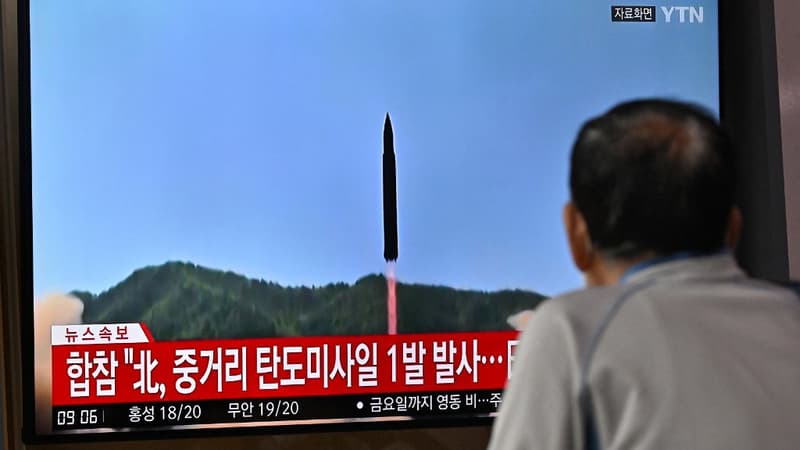North Korea fired a medium-range ballistic missile over Japan on Tuesday for the first time since 2017, marking a clear escalation in Pyongyang’s intensive weapons testing campaign.
Pyongyang’s last missile launch over Japan was in 2017, at the height of the “fire and fury” period in which North Korean leader Kim Jong Un and then-US President Donald Trump exchanged insults.
On Tuesday, the South Korean military said it detected the firing of a medium-range ballistic missile, which flew at a distance of about 4,500 km at an altitude of 970 km, at a speed close to Mach 17, flying over Japan in the direction East.
“The exact details are being thoroughly analyzed in cooperation with the United States and the international community,” South Korea’s Joint Chiefs of Staff said in a statement.
Japan asks affected residents to evacuate
Seoul called the dismissal a “provocation” that “clearly violates universal principles and United Nations norms.” South Korean President Yoon Suk-yeol promised a “strong response” and take “appropriate measures in cooperation with the United States and the international community.”
Tokyo also confirmed the shot, unusually activating the country’s missile warning system and asking the affected population to evacuate.
“A ballistic missile probably passed over our country before falling into the Pacific Ocean. This is an act of violence that follows the recent repeated firing of ballistic missiles. We strongly condemn it,” Prime Minister Fumio Kishida told reporters.
According to Japanese Defense Minister Yasukazu Hamada, it could be a Hwasong-12 missile, launched by Pyongyang “four times” in the past. If so, this shot would mark a new distance record, with Tokyo estimated at about 4,500 km.
Seoul-Tokyo-Washington alliance
With talks stalled with Pyongyang, nuclear-armed North Korea has stepped up its weapons modernization plans this year, including a record number of weapons tests.
In particular, it launched an intercontinental ballistic missile (ICBM) for the first time since 2017 and revised its legislation to make its status as a nuclear power “irreversible”. Last week, he fired four short-range ballistic missiles.
The shooting came as Seoul, Tokyo and Washington on September 30 held trilateral anti-submarine exercises for the first time in five years, days after US and South Korean naval forces staged large-scale exercises off the peninsula.
The Vice President of the United States, Kamala Harris, who was in Seoul the day before, visited the demilitarized zone (DMZ) between the two Koreas, on a trip to underscore Washington’s “unwavering” commitment to defending South Korea against the North. .
US consults allies for a ‘robust’ response
The United States has consulted with Japan and South Korea for a “robust” response to the firing, the White House said. US National Security Adviser Jack Sullivan spoke separately with his South Korean and Japanese counterparts to craft an “adequate and robust international” response.
It reaffirmed the “strong commitment” of the United States to the defense of Japan and South Korea, spokeswoman Adrienne Watson said in a statement.
In a separate statement, the US Asia-Pacific Command condemned the launch, saying Washington’s “commitments to the defense of Japan and Korea remain unwavering.”
“The United States condemns these actions and calls on the DPRK to refrain from further illegal and destabilizing acts,” it said in a statement, using the official abbreviation for North Korea.
“A cycle of provocations and tests”
North Korea, which is subject to UN sanctions for its weapons programmes, generally seeks to maximize the geopolitical impact of its tests by choosing the moment it sees fit.
“If Pyongyang were to fire a missile at Japan, it could represent a significant escalation of its recent provocations,” said Leif-Eric Easley, a professor at Ewha University in Seoul.
“Pyongyang is still in the midst of a cycle of provocations and tests,” he added.
“Mr. Kim’s regime is developing weapons such as tactical nuclear warheads and submarine-launched ballistic missiles as part of a long-term strategy to outdo South Korea in an arms race and sow discord among America’s allies,” it added. .
The fear of seeing North Korea acquire nuclear weapons
South Korean and US officials have been warning for months that North Korean leader Kim Jong Un is preparing to conduct another nuclear test.
It could take place after the next Chinese Communist Party congress that begins on October 16, several senior officials at the US Asia-Pacific Command said this weekend.
The idea of North Korea having a nuclear weapon is all the more troubling since, unlike other nuclear powers, the Pyongyang regime does not view such weapons as a deterrent that will never be used.
Pyongyang has tested atomic bombs six times since 2006. The last and most powerful test was in 2017, with an estimated yield of 250 kilotons.
Source: BFM TV


